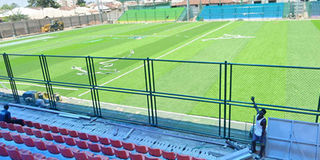Counties must boost efforts to improve national sports facilities

A side view of the Uwanja wa mbuzi artificial turf in Kongowea, Mombasa County on March 30, 2017. PHOTO | KEVIN ODIT |
What you need to know:
- It is a quite disheartening situation as stadiums remain the only place where our sportsmen and women can train and showcase their talents.
- Finally, it would be ideal if President Uhuru Kenyatta who is serving his final term in office would consider increasing the allocation of funds for sports development to counties.
- Further, the Sports Fund, which was borne out of the taxation wars that heavily affected betting and lottery firms, should be structured in a way that the intended beneficiaries benefit the most.
Kenya boasts a number of successful sports personalities who have chosen to give back to society.
Prime examples include star footballers Victor Wanyama and Michael Olunga and former national team captain Dennis Oliech, who have embarked on efforts to groom football talents at the grassroots.
And even though it has struggled in its efforts to improve on the existing sports infrastructure, the national government too, has played a role in the promotion of sports, especially by bankrolling national teams to international assignments and rewarding our globe-conquering heroes and heroines.
Corporates have also participated in these initiatives by sponsoring national teams and clubs. Crucially though, these efforts have all been sorely inadequate.
This is where County governments ought to come in, I believe, because sports development without a doubt requires joint efforts by all available stakeholders.
On an encouraging note, the Nairobi County government is among the few that have and continue to play their part. The County’s sports Minister Janet Muthoni recently enlisted Oliech, Musa Otieno, who also is a former Harambee Stars captain and their ex-colleague Hashim Kamau to to the county sports board.
These ex-internationals deserve this opportunity to not only infuse their experience and exposure on how sportsmen and women should be managed, but also to continue contributing to the growth of sports after hanging their boots.
Special mention also goes to Kakamega County for roping in former AFC Leopards and El Merreikh (Sudan) striker Allan Wanga. Machakos Governor Alfred Mutua has, meanwhile, opted a different route in his bid to promote sports.
He put up an 8,000 seater sports facility that has since been cleared to host SportPesa Premier League and international assignments.
Kisii, Narok and Kakamega counties have also refurbished their stadiums with Bukhungu, in particular, staging select matches of the 2017 Cecafa Senior Challenge Cup.
In Mombasa, Ali Hassan Joho has constructed a number of sports grounds and also repeatedly announced his desire to commence renovation works on Mombasa County stadiums.
Nairobi’s Mike Sonko is complementing the efforts of his Sports county executive member with plans to build and upgrade sports facilities in Dandora, Kangemi, Dagorreti and Woodley with future plans targeting the renovation of the run-down City stadium.
Meanwhile, not much is happening in Kisumu, arguably one of the bedrocks of national footballing talent.
The situation is replicated in Bomet and Trans Nzoia counties, where efforts to renovate sports stadiums there have not been followed through.
Former Bomet Governor Isaac Ruto had rolled out the plans to construct a sports facility but he seems to have left office with that particular vision.
It is a quite disheartening situation as stadiums remain the only place where our sportsmen and women can train and showcase their talents.
Finally, it would be ideal if President Uhuru Kenyatta who is serving his final term in office would consider increasing the allocation of funds for sports development to counties.
Further, the Sports Fund, which was borne out of the taxation wars that heavily affected betting and lottery firms, should be structured in a way that the intended beneficiaries benefit the most.




